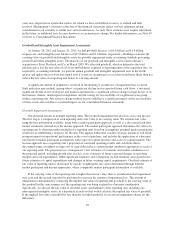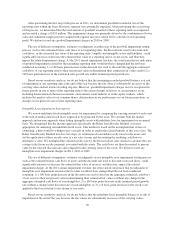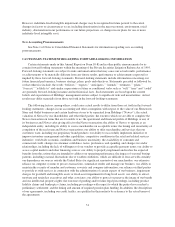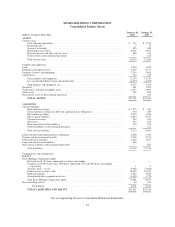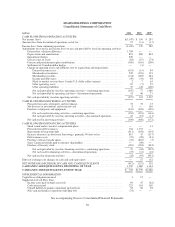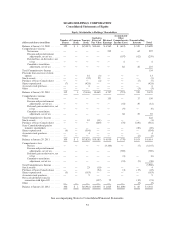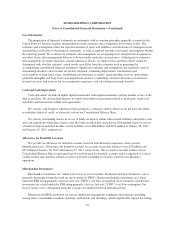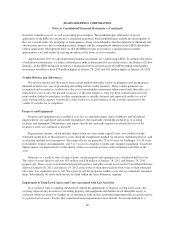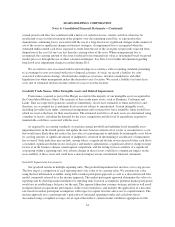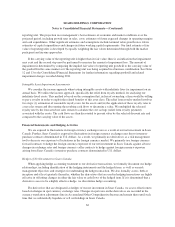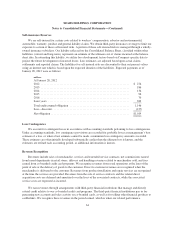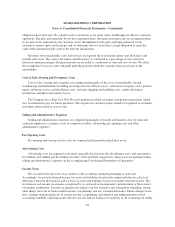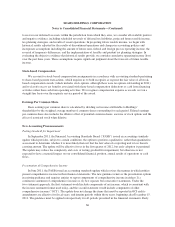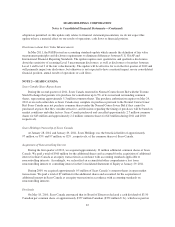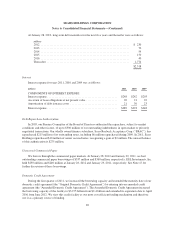Sears 2011 Annual Report Download - page 59
Download and view the complete annual report
Please find page 59 of the 2011 Sears annual report below. You can navigate through the pages in the report by either clicking on the pages listed below, or by using the keyword search tool below to find specific information within the annual report.SEARS HOLDINGS CORPORATION
Notes to Consolidated Financial Statements—(Continued)
Use of Estimates
The preparation of financial statements in conformity with accounting principles generally accepted in the
United States of America requires management to make estimates and assumptions about future events. The
estimates and assumptions affect the reported amounts of assets and liabilities and disclosure of contingent assets
and liabilities at the date of the financial statements, as well as reported amounts of revenues and expenses during
the reporting period. We evaluate our estimates and assumptions on an ongoing basis using historical experience
and other factors that management believes to be reasonable under the circumstances. Adjustments to estimates
and assumptions are made when facts and circumstances dictate. As future events and their effects cannot be
determined with absolute certainty, actual results may differ from the estimates used in preparing the
accompanying consolidated financial statements. Significant estimates and assumptions are required as part of
determining inventory and accounts receivable valuation, estimating depreciation, amortization and
recoverability of long-lived assets, establishing self-insurance, warranty, legal and other reserves, performing
goodwill, intangible and long-lived asset impairment analysis, establishing valuation allowances on deferred
income tax assets and reserves for tax examination exposures, and calculating retirement benefits.
Cash and Cash Equivalents
Cash equivalents include all highly liquid investments with original maturities of three months or less at the
date of purchase. We also include deposits in-transit from banks for payments related to third-party credit card
and debit card transactions within cash equivalents.
We classify cash balances which have been pledged as collateral, and for which we do not have the ability
to substitute letters of credit, as restricted cash on our Consolidated Balance Sheet.
We classify outstanding checks in excess of funds on deposit within other current liabilities and reduce cash
and cash equivalents when these checks clear the bank on which they were drawn. Outstanding checks in excess
of funds on deposit included in other current liabilities were $68 million and $122 million at January 28, 2012
and January 29, 2011, respectively.
Allowance for Doubtful Accounts
We provide an allowance for doubtful accounts based on both historical experience and a specific
identification basis. Allowances for doubtful accounts on accounts receivable balances were $28 million and
$35 million at January 28, 2012 and January 29, 2011, respectively. Our accounts receivable balance on our
Consolidated Balance Sheet is presented net of our allowance for doubtful accounts and is comprised of various
vendor-related and customer-related accounts receivable, including receivables related to our pharmacy
operations.
Merchandise Inventories
Merchandise inventories are valued at the lower of cost or market. For Kmart and Sears Domestic, cost is
primarily determined using the retail inventory method (“RIM”). Kmart merchandise inventories are valued
under the RIM using primarily a first-in, first-out (“FIFO”) cost flow assumption. Sears Domestic merchandise
inventories are valued under the RIM using primarily a last-in, first-out (“LIFO”) cost flow assumption. For
Sears Canada, cost is determined using the average cost method based on individual items.
Inherent in the RIM calculation are certain significant management judgments and estimates including,
among others, merchandise markons, markups, markdowns and shrinkage, which significantly impact the ending
59


